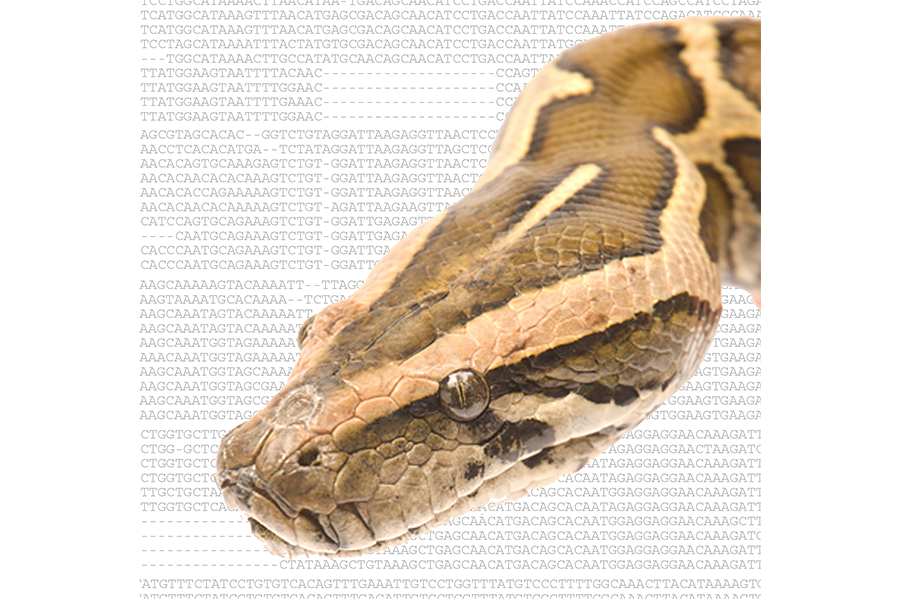How did snakes lose their legs?
Loading...
Snakes haven't always been obligate stomach slitherers. The animals' ancestors scuttled around on legs, scientists say.
And geneticists now think they know what happened.
Previously, scientists thought the change had something to do with a gene associated with limb growth across vertebrates, but the animals' genomes suggested that gene, called sonic hedgehog, hadn't been deleted. Now, two research teams have independently concluded that portions of the DNA that control the sonic hedgehog (Shh) gene had been deleted.
"The modification of small pieces of DNA can generate big changes," says biologist Francisca Leal, who conducted one of the studies.
So what happened?
Sometime after snakes and lizards diverged from their common ancestor, snakes lost their forelimbs. But tiny hindlimbs remained in the last common ancestor of all living snakes, which scientists suggest lived around 128 million years ago.
While most snakes today have no remnants of those hind legs, pythons, boas, and their relatives retain some related primitive structures. These snakes can have a pelvic girdle, the remnant of a femur and a little claw, called a spur, sticking out.
Pythons briefly develop the beginnings of limbs as embryos, and previous research had suggested the Shh gene had something to do with this flicker of limb growth.
So Ms. Leal, as a PhD candidate in Martin Cohn's lab at the University of Florida, dug into python genomes to see what was turning the gene expression off.
In the genome, short sequences of DNA called enhancers are involved in triggering gene activity. And, because Shh is involved in the development of structures other than limbs, there is a specific enhancer associated with limb development, called the ZRS, Dr. Cohn tells The Christian Science Monitor. "The only job of this short stretch of DNA is to turn on sonic hedgehog in the limb buds," he says.
Leal and Cohn found that pythons do have a ZRS, but sections of it have been deleted. And without those key pieces of the limb-specific enhancer, the proteins that bind to the DNA to kick off limb growth can't latch on.
The pair came to these conclusions, published Thursday in the journal Current Biology, by inserting the limb enhancer DNA into the genetics of a normal mouse. With this extra ZRS marked to highlight when the enhancer triggered activity, the team was able to see that the mice "showed very weak activity of the enhancer in just a few cells at a very early stage, and it's not sustained, just like in pythons," Cohn says.
Meanwhile, in California, another team was independently approaching the same problem from another angle.
Instead of simply adding a python's ZRS to normal mice, a team of researchers led by Axel Visel at the Lawrence Berkeley National Laboratory used the gene editing technology CRISPR to replace this segment of DNA in mice with those from other animals including fish, platypuses, bats, chickens, and five different kinds of snakes.
Dr. Visel and his team saw normal limb development in the mice in all cases except when they had snake ZRS in them.
"Even though the sequence is there ... these mice can no longer form proper limbs," Visel tells the Monitor. And, he adds, "If you take the sequence from the snakes that have the most reduced limbs – the advanced snakes – then essentially these mice look just like mice whose regulatory sequence has been completely deleted."
But with the ZRS from less-advanced snakes like pythons, the mice still produced puny little stubs in place of full limbs. This suggests that the ZRS is still somewhat active in the python, which fits with the minimal structures these snakes and their relatives have retained.
Visel's research was also published Thursday, in the journal Cell.
"It is a marvelous example of evolution being understood in genetic detail," Clifford Tabin, an evolutionary geneticist at Harvard University who was not involved in either study, writes in an email to the Monitor. "This is one of the few cases where we know the exact mutations responsible for dramatic changes in the way evolution has sculpted changes in the body plan of animals."
The ZRS is probably just one piece of the puzzle of limb loss in snakes, says Visel. Many other genes play key roles in limb development, and many of them also have regulatory sequences. "We assume that many of these other sequences probably also have undergone a similar functional degradation," he says, but scientists have yet to identify them.
Cohn agrees that the ZRS is probably only part of the story, particularly because the pythons still show a "pulse" of associated activity and limb development.
Limbs had already been disappearing in snake ancestors by the time pythons and their relatives diverged from other snake lineages, he adds. "Pythons and boas … sort of preserved that state of genome evolution in their lineage," Cohn says, thus providing a "kind of intermediate snapshot of a process that was underway, this degeneration of these gene regulatory elements."
This research isn't just about snakes becoming limbless, Visel says. "All vertebrate species share essentially the same set of genes," he explains. "There are not huge differences."
So scientists have puzzled over why different species look so different.
"There has been this hypothesis that much of what makes animal species different from each other has to do with just how these genes are regulated," Visel says. Finding evidence for that has been a challenge, until these limbless snakes provided an opportunity.








